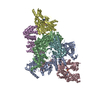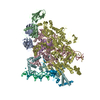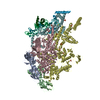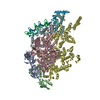+ Open data
Open data
- Basic information
Basic information
| Entry | Database: PDB / ID: 7kw7 | ||||||
|---|---|---|---|---|---|---|---|
| Title | Atomic cryoEM structure of Hsp90-Hsp70-Hop-GR | ||||||
 Components Components |
| ||||||
 Keywords Keywords |  CHAPERONE / Client-loading CHAPERONE / Client-loading | ||||||
| Function / homology |  Function and homology information Function and homology informationpositive regulation of endoribonuclease activity / denatured protein binding / Regulation of NPAS4 gene transcription / cellular heat acclimation / regulation of glucocorticoid biosynthetic process / nuclear glucocorticoid receptor activity / negative regulation of inclusion body assembly / Viral RNP Complexes in the Host Cell Nucleus / positive regulation of nucleotide-binding oligomerization domain containing 2 signaling pathway / death receptor agonist activity ...positive regulation of endoribonuclease activity / denatured protein binding / Regulation of NPAS4 gene transcription / cellular heat acclimation / regulation of glucocorticoid biosynthetic process / nuclear glucocorticoid receptor activity / negative regulation of inclusion body assembly / Viral RNP Complexes in the Host Cell Nucleus / positive regulation of nucleotide-binding oligomerization domain containing 2 signaling pathway / death receptor agonist activity / C3HC4-type RING finger domain binding / dynein axonemal particle /  steroid hormone binding / PTK6 Expression / ATP-dependent protein disaggregase activity / positive regulation of microtubule nucleation / neuroinflammatory response / glucocorticoid metabolic process / microglia differentiation / steroid hormone binding / PTK6 Expression / ATP-dependent protein disaggregase activity / positive regulation of microtubule nucleation / neuroinflammatory response / glucocorticoid metabolic process / microglia differentiation /  maternal behavior / mammary gland duct morphogenesis / nucleus localization / maternal behavior / mammary gland duct morphogenesis / nucleus localization /  misfolded protein binding / misfolded protein binding /  regulation of mitotic spindle assembly / positive regulation of tumor necrosis factor-mediated signaling pathway / negative regulation of mitochondrial outer membrane permeabilization involved in apoptotic signaling pathway / astrocyte differentiation / cellular response to interleukin-7 / protein folding chaperone complex / transcription regulator inhibitor activity / cellular response to glucocorticoid stimulus / regulation of mitotic spindle assembly / positive regulation of tumor necrosis factor-mediated signaling pathway / negative regulation of mitochondrial outer membrane permeabilization involved in apoptotic signaling pathway / astrocyte differentiation / cellular response to interleukin-7 / protein folding chaperone complex / transcription regulator inhibitor activity / cellular response to glucocorticoid stimulus /  aggresome / RND1 GTPase cycle / aggresome / RND1 GTPase cycle /  motor behavior / lysosomal transport / sperm mitochondrial sheath / motor behavior / lysosomal transport / sperm mitochondrial sheath /  dATP binding / Scavenging by Class F Receptors / dATP binding / Scavenging by Class F Receptors /  sulfonylurea receptor binding / CTP binding / positive regulation of protein polymerization / vRNP Assembly / UTP binding / sperm plasma membrane / positive regulation of tau-protein kinase activity / protein insertion into mitochondrial outer membrane / sulfonylurea receptor binding / CTP binding / positive regulation of protein polymerization / vRNP Assembly / UTP binding / sperm plasma membrane / positive regulation of tau-protein kinase activity / protein insertion into mitochondrial outer membrane /  regulation of gluconeogenesis / regulation of gluconeogenesis /  chaperone-mediated autophagy / chaperone-mediated autophagy /  telomerase holoenzyme complex assembly / adrenal gland development / Rho GDP-dissociation inhibitor binding / cellular response to steroid hormone stimulus / Uptake and function of diphtheria toxin / mitochondrial transport / Drug-mediated inhibition of ERBB2 signaling / Resistance of ERBB2 KD mutants to trastuzumab / Resistance of ERBB2 KD mutants to sapitinib / Resistance of ERBB2 KD mutants to tesevatinib / Resistance of ERBB2 KD mutants to neratinib / Resistance of ERBB2 KD mutants to osimertinib / Resistance of ERBB2 KD mutants to afatinib / Resistance of ERBB2 KD mutants to AEE788 / Resistance of ERBB2 KD mutants to lapatinib / telomerase holoenzyme complex assembly / adrenal gland development / Rho GDP-dissociation inhibitor binding / cellular response to steroid hormone stimulus / Uptake and function of diphtheria toxin / mitochondrial transport / Drug-mediated inhibition of ERBB2 signaling / Resistance of ERBB2 KD mutants to trastuzumab / Resistance of ERBB2 KD mutants to sapitinib / Resistance of ERBB2 KD mutants to tesevatinib / Resistance of ERBB2 KD mutants to neratinib / Resistance of ERBB2 KD mutants to osimertinib / Resistance of ERBB2 KD mutants to afatinib / Resistance of ERBB2 KD mutants to AEE788 / Resistance of ERBB2 KD mutants to lapatinib /  Drug resistance in ERBB2 TMD/JMD mutants / PIWI-interacting RNA (piRNA) biogenesis / TPR domain binding / Drug resistance in ERBB2 TMD/JMD mutants / PIWI-interacting RNA (piRNA) biogenesis / TPR domain binding /  non-chaperonin molecular chaperone ATPase / regulation of postsynaptic membrane neurotransmitter receptor levels / mRNA catabolic process / dendritic growth cone / chaperone cofactor-dependent protein refolding / Sema3A PAK dependent Axon repulsion / skeletal muscle contraction / regulation of protein ubiquitination / positive regulation of cell size / protein unfolding / HSF1-dependent transactivation / telomere maintenance via telomerase / response to unfolded protein / negative regulation of extrinsic apoptotic signaling pathway in absence of ligand / HSF1 activation / Regulation of HSF1-mediated heat shock response / chaperone-mediated protein complex assembly / regulation of protein-containing complex assembly / Attenuation phase / cellular response to unfolded protein / non-chaperonin molecular chaperone ATPase / regulation of postsynaptic membrane neurotransmitter receptor levels / mRNA catabolic process / dendritic growth cone / chaperone cofactor-dependent protein refolding / Sema3A PAK dependent Axon repulsion / skeletal muscle contraction / regulation of protein ubiquitination / positive regulation of cell size / protein unfolding / HSF1-dependent transactivation / telomere maintenance via telomerase / response to unfolded protein / negative regulation of extrinsic apoptotic signaling pathway in absence of ligand / HSF1 activation / Regulation of HSF1-mediated heat shock response / chaperone-mediated protein complex assembly / regulation of protein-containing complex assembly / Attenuation phase / cellular response to unfolded protein /  estrogen response element binding / FOXO-mediated transcription of oxidative stress, metabolic and neuronal genes / RHOBTB2 GTPase cycle / positive regulation of lamellipodium assembly / negative regulation of endoplasmic reticulum stress-induced intrinsic apoptotic signaling pathway / eNOS activation / estrogen response element binding / FOXO-mediated transcription of oxidative stress, metabolic and neuronal genes / RHOBTB2 GTPase cycle / positive regulation of lamellipodium assembly / negative regulation of endoplasmic reticulum stress-induced intrinsic apoptotic signaling pathway / eNOS activation /  DNA polymerase binding / axonal growth cone / intracellular steroid hormone receptor signaling pathway / ATP metabolic process / DNA polymerase binding / axonal growth cone / intracellular steroid hormone receptor signaling pathway / ATP metabolic process /  inclusion body / protein folding chaperone / core promoter sequence-specific DNA binding / Tetrahydrobiopterin (BH4) synthesis, recycling, salvage and regulation inclusion body / protein folding chaperone / core promoter sequence-specific DNA binding / Tetrahydrobiopterin (BH4) synthesis, recycling, salvage and regulationSimilarity search - Function | ||||||
| Biological species |   Homo sapiens (human) Homo sapiens (human) | ||||||
| Method |  ELECTRON MICROSCOPY / ELECTRON MICROSCOPY /  single particle reconstruction / single particle reconstruction /  cryo EM / Resolution: 3.57 Å cryo EM / Resolution: 3.57 Å | ||||||
 Authors Authors | Wang, R.Y. / Noddings, C.M. / Kirschke, E. / Myasnikov, A. / Johnson, J.L. / Agard, D.A. | ||||||
| Funding support |  United States, 1items United States, 1items
| ||||||
 Citation Citation |  Journal: Nature / Year: 2022 Journal: Nature / Year: 2022Title: Structure of Hsp90-Hsp70-Hop-GR reveals the Hsp90 client-loading mechanism. Authors: Ray Yu-Ruei Wang / Chari M Noddings / Elaine Kirschke / Alexander G Myasnikov / Jill L Johnson / David A Agard /   Abstract: Maintaining a healthy proteome is fundamental for the survival of all organisms. Integral to this are Hsp90 and Hsp70, molecular chaperones that together facilitate the folding, remodelling and ...Maintaining a healthy proteome is fundamental for the survival of all organisms. Integral to this are Hsp90 and Hsp70, molecular chaperones that together facilitate the folding, remodelling and maturation of the many 'client proteins' of Hsp90. The glucocorticoid receptor (GR) is a model client protein that is strictly dependent on Hsp90 and Hsp70 for activity. Chaperoning GR involves a cycle of inactivation by Hsp70; formation of an inactive GR-Hsp90-Hsp70-Hop 'loading' complex; conversion to an active GR-Hsp90-p23 'maturation' complex; and subsequent GR release. However, to our knowledge, a molecular understanding of this intricate chaperone cycle is lacking for any client protein. Here we report the cryo-electron microscopy structure of the GR-loading complex, in which Hsp70 loads GR onto Hsp90, uncovering the molecular basis of direct coordination by Hsp90 and Hsp70. The structure reveals two Hsp70 proteins, one of which delivers GR and the other scaffolds the Hop cochaperone. Hop interacts with all components of the complex, including GR, and poises Hsp90 for subsequent ATP hydrolysis. GR is partially unfolded and recognized through an extended binding pocket composed of Hsp90, Hsp70 and Hop, revealing the mechanism of GR loading and inactivation. Together with the GR-maturation complex structure, we present a complete molecular mechanism of chaperone-dependent client remodelling, and establish general principles of client recognition, inhibition, transfer and activation. | ||||||
| History |
|
- Structure visualization
Structure visualization
| Movie |
 Movie viewer Movie viewer |
|---|---|
| Structure viewer | Molecule:  Molmil Molmil Jmol/JSmol Jmol/JSmol |
- Downloads & links
Downloads & links
- Download
Download
| PDBx/mmCIF format |  7kw7.cif.gz 7kw7.cif.gz | 1012.5 KB | Display |  PDBx/mmCIF format PDBx/mmCIF format |
|---|---|---|---|---|
| PDB format |  pdb7kw7.ent.gz pdb7kw7.ent.gz | 855.4 KB | Display |  PDB format PDB format |
| PDBx/mmJSON format |  7kw7.json.gz 7kw7.json.gz | Tree view |  PDBx/mmJSON format PDBx/mmJSON format | |
| Others |  Other downloads Other downloads |
-Validation report
| Arichive directory |  https://data.pdbj.org/pub/pdb/validation_reports/kw/7kw7 https://data.pdbj.org/pub/pdb/validation_reports/kw/7kw7 ftp://data.pdbj.org/pub/pdb/validation_reports/kw/7kw7 ftp://data.pdbj.org/pub/pdb/validation_reports/kw/7kw7 | HTTPS FTP |
|---|
-Related structure data
| Related structure data |  23050MC M: map data used to model this data C: citing same article ( |
|---|---|
| Similar structure data |
- Links
Links
- Assembly
Assembly
| Deposited unit | 
|
|---|---|
| 1 |
|
- Components
Components
-Protein , 4 types, 6 molecules ABCDEF
| #1: Protein |  Heat shock response / Heat shock 86 kDa / HSP86 / Lipopolysaccharide-associated protein 2 / LPS-associated protein 2 / ...Heat shock 86 kDa / HSP86 / Lipopolysaccharide-associated protein 2 / LPS-associated protein 2 / Renal carcinoma antigen NY-REN-38 Heat shock response / Heat shock 86 kDa / HSP86 / Lipopolysaccharide-associated protein 2 / LPS-associated protein 2 / ...Heat shock 86 kDa / HSP86 / Lipopolysaccharide-associated protein 2 / LPS-associated protein 2 / Renal carcinoma antigen NY-REN-38Mass: 84781.727 Da / Num. of mol.: 2 Source method: isolated from a genetically manipulated source Source: (gene. exp.)   Homo sapiens (human) / Gene: HSP90AA1, HSP90A, HSPC1, HSPCA / Production host: Homo sapiens (human) / Gene: HSP90AA1, HSP90A, HSPC1, HSPCA / Production host:   Escherichia coli (E. coli) / References: UniProt: P07900 Escherichia coli (E. coli) / References: UniProt: P07900#2: Protein | Mass: 70140.133 Da / Num. of mol.: 2 Source method: isolated from a genetically manipulated source Source: (gene. exp.)   Homo sapiens (human) / Gene: HSPA1A, HSP72, HSPA1, HSX70 / Production host: Homo sapiens (human) / Gene: HSPA1A, HSP72, HSPA1, HSX70 / Production host:  unidentified baculovirus / References: UniProt: P0DMV8 unidentified baculovirus / References: UniProt: P0DMV8#3: Protein | | Mass: 62738.301 Da / Num. of mol.: 1 Source method: isolated from a genetically manipulated source Source: (gene. exp.)   Homo sapiens (human) / Gene: STIP1 / Production host: Homo sapiens (human) / Gene: STIP1 / Production host:   Escherichia coli (E. coli) / References: UniProt: P31948 Escherichia coli (E. coli) / References: UniProt: P31948#4: Protein | |  / GR / Nuclear receptor subfamily 3 group C member 1 / GR / Nuclear receptor subfamily 3 group C member 1Mass: 85673.906 Da / Num. of mol.: 1 / Mutation: F602S Source method: isolated from a genetically manipulated source Source: (gene. exp.)   Homo sapiens (human) / Gene: NR3C1, GRL / Production host: Homo sapiens (human) / Gene: NR3C1, GRL / Production host:   Escherichia coli (E. coli) / References: UniProt: P04150 Escherichia coli (E. coli) / References: UniProt: P04150 |
|---|
-Non-polymers , 3 types, 6 molecules 




| #5: Chemical |  Adenosine diphosphate Adenosine diphosphate#6: Chemical | #7: Chemical | |
|---|
-Details
| Has ligand of interest | N |
|---|
-Experimental details
-Experiment
| Experiment | Method:  ELECTRON MICROSCOPY ELECTRON MICROSCOPY |
|---|---|
| EM experiment | Aggregation state: PARTICLE / 3D reconstruction method:  single particle reconstruction single particle reconstruction |
- Sample preparation
Sample preparation
| Component |
| ||||||||||||||||||||||||||||||||||||
|---|---|---|---|---|---|---|---|---|---|---|---|---|---|---|---|---|---|---|---|---|---|---|---|---|---|---|---|---|---|---|---|---|---|---|---|---|---|
| Source (natural) |
| ||||||||||||||||||||||||||||||||||||
| Source (recombinant) |
| ||||||||||||||||||||||||||||||||||||
| Buffer solution | pH: 7.5 | ||||||||||||||||||||||||||||||||||||
| Specimen | Embedding applied: NO / Shadowing applied: NO / Staining applied : NO / Vitrification applied : NO / Vitrification applied : YES : YES | ||||||||||||||||||||||||||||||||||||
Vitrification | Cryogen name: ETHANE-PROPANE |
- Electron microscopy imaging
Electron microscopy imaging
| Experimental equipment |  Model: Titan Krios / Image courtesy: FEI Company |
|---|---|
| Microscopy | Model: FEI TITAN KRIOS |
| Electron gun | Electron source : :  FIELD EMISSION GUN / Accelerating voltage: 300 kV / Illumination mode: FLOOD BEAM FIELD EMISSION GUN / Accelerating voltage: 300 kV / Illumination mode: FLOOD BEAM |
| Electron lens | Mode: BRIGHT FIELD Bright-field microscopy Bright-field microscopy |
| Image recording | Electron dose: 80 e/Å2 / Film or detector model: GATAN K2 SUMMIT (4k x 4k) |
- Processing
Processing
| EM software |
| ||||||||||||||||||||
|---|---|---|---|---|---|---|---|---|---|---|---|---|---|---|---|---|---|---|---|---|---|
CTF correction | Type: PHASE FLIPPING AND AMPLITUDE CORRECTION | ||||||||||||||||||||
3D reconstruction | Resolution: 3.57 Å / Resolution method: FSC 0.143 CUT-OFF / Num. of particles: 85619 / Symmetry type: POINT | ||||||||||||||||||||
| Atomic model building | B value: 80 / Protocol: FLEXIBLE FIT / Space: REAL |
 Movie
Movie Controller
Controller
















 PDBj
PDBj






































